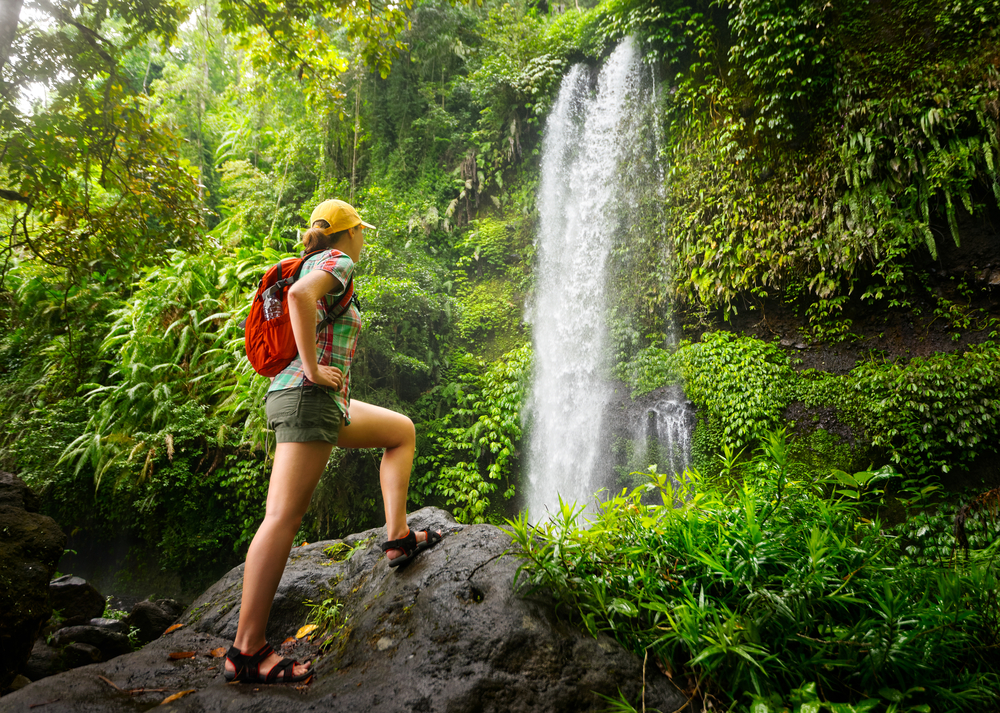
If you’re an avid RV camper, or even just thinking about breaking into it for the first time, chances are the planet means a lot to you. (Heck, we hope the planet means a lot to you even if you’ve never traveled a day in your life — after all, it’s what’s keeping us all alive and breathing!)
But for those of us with a serious case of wanderlust, there’s a bit of a conundrum. After all, getting places takes energy, and now that we’ve traded our horse-drawn carriages for trains, planes, and automobiles, that energy comes largely in the form of non-renewable, petroleum-based resources.
Fortunately for our itineraries, gas, coal, and diesel can get us where we’re going quickly. But unfortunately, burning those fuels (not to mention the process of harvesting them) can wreak havoc on the planet we’re so gung-ho to experience.
Which is why some groups and individual travelers have found ways to combine their love of the earth with their desire to see more of it in the form of ecotourism, or eco-friendly travel habits.
But what, exactly, do eco travels look like? What kinds of activities and destinations are part of responsible tourism?
In this post, we’ll go over everything you need to know about ecotourism, starting with its definition before moving onto its benefits, popularity, and how to take an eco trip of your very own.
What is Ecotourism?
Let’s start from the very top and get a handle on what kinds of travels this term refers to.
Per ecotourism.org, one of the largest and most reliable sites dedicated to the movement, ecotourism is “responsible travel to natural areas that conserves the environment, sustains the well-being of the local people, and involves interpretation and education.” This kind of responsible tourism is based on a number of principles, which are designed to help travelers uphold the mission of seeing the world while minimizing their negative impact — and even creating positive change, in some cases.
The official principles of ecotourism are as follows:
- Minimize physical, social, behavioral, and psychological impacts.
- Build environmental and cultural awareness and respect.
- Provide positive experiences for both visitors and hosts.
- Provide direct financial benefits for conservation.
- Generate financial benefits for both local people and private industry.
- Deliver memorable interpretative experiences to visitors that help raise sensitivity to host countries’ political, environmental, and social climates.
- Design, construct and operate low-impact facilities.
- Recognize the rights and spiritual beliefs of the Indigenous People in your community and work in partnership with them to create empowerment.
As you can see, all of these principles are geared toward improving the lives of both travelers and hosts, as well as respecting and caring for the environments being traveled to.
So, what exactly does this kind of travel look like? Glad you asked.

Ecotourism Examples
Although its goals may sound lofty, ecotourism doesn’t actually have to be all that hard to implement. It’s more about how you approach the travel decisions you make on a day-by-day basis than organizing a whole trip specifically around the idea of responsibility.
For example, when you’re traveling in a foreign country (or even just a new American city), supporting small businesses by dining at local restaurants or patronizing local campgrounds is a form of ecotourism, since it’s helping to stimulate the local economy rather than putting money into the hands of a large corporation.
As RV campers, another common way to implement an ecotourism approach to your travels is to focus on nature tourism, particularly that which educates visitors and aids endangered wildlife. For instance, visiting (and paying the entry fees) for National Wildlife Refuges both gives you and your family the opportunity to encounter some new and exciting animals and supports conservation efforts, since the funds are used to help maintain and improve these natural areas set aside for their use. You can also find private wildlife conservation programs throughout the United States in almost any destination you can imagine; for example, the historic beach town of St. Augustine, Florida is home to a nonprofit wildlife reserve that functions largely thanks to visitor contributions.
You could also choose to create a trip specifically for some dedicated conservation effort, such as volunteering on a sea turtle nesting beach to ensure as many baby sea turtles as possible reach their watery destination and get a fighting chance at life. And, of course, staying aware of your consumption and waste management are keys to creating a sustainable lifestyle every day, whether you’re traveling or no.
Ecotourism Ideas for Your Next Adventure
Want to fashion an eco holiday of your own? Here are some ecotourism destinations and activities to consider.
Visit a national park or wildlife refuge.
As we mentioned above, you don’t have to take on a strenuous volunteer position to help create real changes. You can do your part just by visiting a nationally-managed wilderness area or refuge, where your fee dollars will be used to continue and improve the conservation work these organizations do. No matter what part of the country you call home (or which corner you’re planning to visit), there’s bound to be an NPS- or U.S.-Fish-and-Wildlife-managed property nearby, and some of them offer unparalleled viewing opportunities for all sorts of rare birds and mammals.
Looking for a few specific ideas for camping trips for animal lovers? Here are some wildlife refuges worth the drive. And by the way, if you’ve got kids along for your national parks tour, you’ve got a great opportunity to help get them excited about the great outdoors and learn how to do their own part to becoming great stewards. It’s called the Junior Ranger program, and here’s how to take advantage of it.
Take a low-impact tour.
Seeing a new place by train or trolley might be easy on your legs, but it’s hard on Mother Earth. But that doesn’t mean you have to trade in every mode of transportation and rely solely on your hiking boots, either.
Whether it’s by bicycle, kayak, or horse-drawn carriage, there are many eco-friendly ways to get around that have very low impacts from a carbon emissions standpoint — and they might be more fun and engaging than sitting on a tour bus, anyway! Look for organized eco tours in your destination, or cobble one together yourself by bringing along your own bike or paddleboard. The world is your oyster!
Get serious about your consumption.
Although all of us contribute to carbon emissions and our overtaxed landfills just by living our lives, there are definitely a number of ways to minimize our impacts, especially while traveling. For example, you can avoid contributing to the breathtaking food waste problem — more than 1.3 billion pounds of edible food is thrown away each year! — by planning your meals ahead of time and sticking to that schedule, especially if you’re traveling by RV, when you have a kitchen at your disposal.
Buying items in bulk, storing them in reusable containers, and avoiding single-use items like paper plates or paper towels are all instrumental in improving the situation. You should also be conservative in your water use, taking short showers and minimizing flushes. (By the way, all these hints will not only help the Earth, but also make you a much more efficient off-grid camper or boondocker!)
For more target tips on reducing your water usage, waste, and more, check out the following RVshare posts:
- Water Saving Hacks When You’re on the Road
- 8 Food Packages that Can be Reused Instead of Tossed
- 5 Effortless Ways to Reduce Daily Waste in your RV and Life
Sustainable Tourism
Although it’s impossible to entirely negate each of the impacts of tourism, by becoming intentional in your actions and choosing destinations and activities that support the principles of sustainability, you can create ecotourism getaways that you can feel good about — and fully enjoy, too. After all, this world of ours is filled with so much wonder, which is exactly what we’re after when we go camping… so doing our part to conserve those places, spaces, and moments for future generations is an imperative part of being a good member of the RV community.
So, campers: how do you make your camping trips more environmentally friendly? What activities and sights have you done and seen that support the ecotourism mission? Let us know — and keep up the good work! Mother Earth and future generations will thank you.
This post may contain affiliate links.

